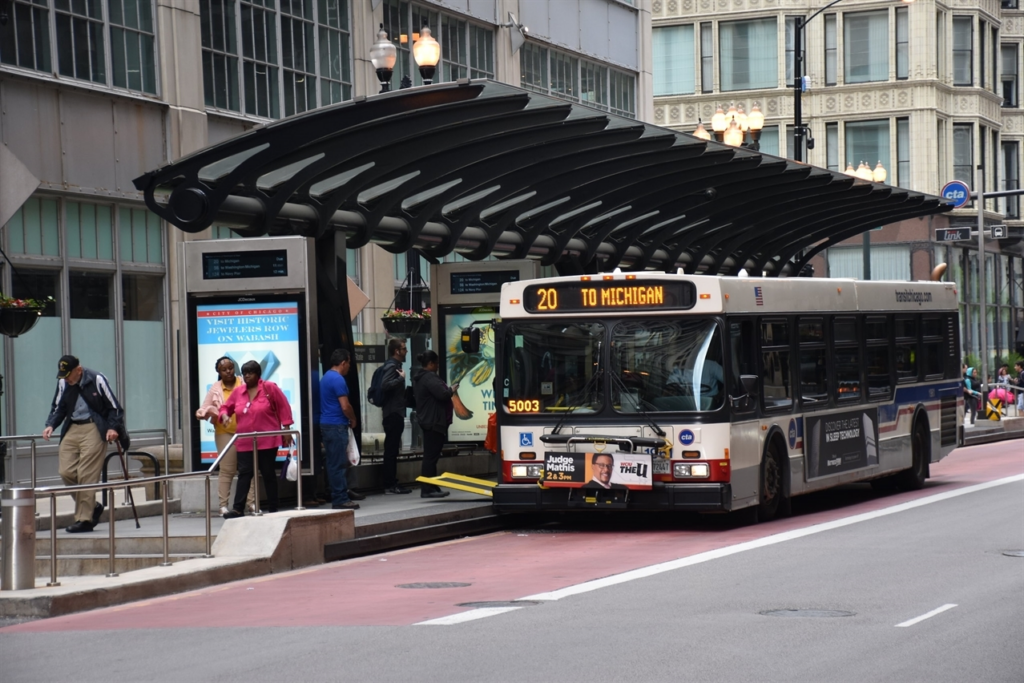It’s Time to Double Down on Speeding Up Buses

The conversation about developing true bus rapid transit (BRT) in Chicago has been going on for years … make that decades. BRT is bus service that is given priority on streets via dedicated travel lanes, gets to go first at traffic signals, and has increased frequency and nicer stations for a great rider experience. Other than a short stretch of the Loop Link, Chicago has very little true BRT with enhanced amenities and dedicated bus lanes. This is what we’ve got currently in Chicago:
- Some segments of painted bus lanes on 1.1 miles of Dearborn downtown
- Segments of dedicated lanes during rush hour for the J14 “Jeffery Jump”
- Some dedicated bus lane segments along Chicago Avenue (rush hour only)
- Some dedicated bus lane segments on 79th Street that are marked with white stencils – not red paint.
Our peers across the U.S are doing it and leaving Chicago in the dust. Indianapolis, which was long behind on transit, sprinted ahead by standing up an entire network of BRT in one fell swoop. New York City’s Select Bus Service of 16 routes started implementation a decade ago and has been speeding up implementation during COVID, including enforcement strategies. Minneapolis has three BRT routes in operation and will be opening five more in the next three years. Miami is building a 20-mile mile BRT, one of six corridors being planned in the Strategic Miami Area Rapid Transit Plan. With significant funding on the way from many programs in the Bipartisan Infrastructure Law, we could get some serious funding to invest in transformative BRT corridors. But we only have 5 years to define the projects and get the funds.
The orientation thus far by CTA and Chicago DOT, who manages city streets, has been to do spot treatments at largely isolated locations, not along complete corridors. Enforcement continues to be a significant problem as even if there is a dedicated lane cars and delivery trucks often drive in the bus lanes causing difficulty for bus operators, and violators rarely are ticketed. But design is also a major issue. Several of our “bus lanes” aren’t marked with a full lane of red paint so they’re barely visible to many drivers, especially after the few white markings fade away over time.
Despite buses carrying the majority of CTA raiders, bus operating speeds in the years prior to COVID had been declining due to buses getting caught in slow traffic. According to New York foundation and transit advocacy organization TransitCenter , transit ridership was decreasing even before COVID and “transit agencies have to compete harder than ever for customers”. In areas of the city with less access to rail – largely on the south and west sides of the city — there is even more urgency to making buses run faster from an equity perspective since, according to TransitCenter, in Chicago “transit provides less access to opportunities for Black and Latinx residents than other residents.” When people have to travel further on the bus to get what they need, speed matters.
CTA just launched its Better Streets for Buses study, which features maps where people can tell CTA where they want priority bus improvements and a toolkit of street treatments. The challenge here is that if individual riders are asked what they want from a list of improvements, they are likely going to define an enhancement where they live or work and not along an entire corridor. Mismatched improvements could be identified all over the city.
The reality is we need to commit to making significant upgrades along entire corridors to see meaningful bus reliability and speed improvements. It’s particularly disappointing to see the 11-mile South Halsted Pace route, one targeted for Pulse rapid transit treatment, be designed with no dedicated lanes despite being the most heavily used route in the Pace system and also part of the CTA network.
The bottom line is we need to double down on a handful of BRT corridors and just start doing it. Why not commit to some of the corridors in the still-valid Bus Rapid Transit: Chicago’s New Route to Opportunity plan developed by MPC in 2011, which identifies a set of 10 priority corridors? More than a decade ago, we identified these corridors as ideal for BRT because they carry a huge volume of riders, connect to many popular destinations, and there’s enough space on the street to add BRT features. All this remains true today.
Another great place to focus would be along bus corridors that were elevated for transit-oriented development incentives via zoning changes in 2019…and more are expected soon.
The beauty of bus is that it’s so much easier and cheaper to build than rail and faster to implement. So what’s the hold-up? We must prioritize a group of corridors, design the BRT projects, and apply for the funds. There is no time to waste or we could lose out big time. Here is a video about the benefits of BRT in Minneapolis. Don’t you want that for Chicago? Please get engaged by visiting the CTA website, emailing the project team at betterstreetsforbuses@transitchicago.com, or calling/texting the project team at (312) 772-5496. Public comment is being accepted until May 31.
